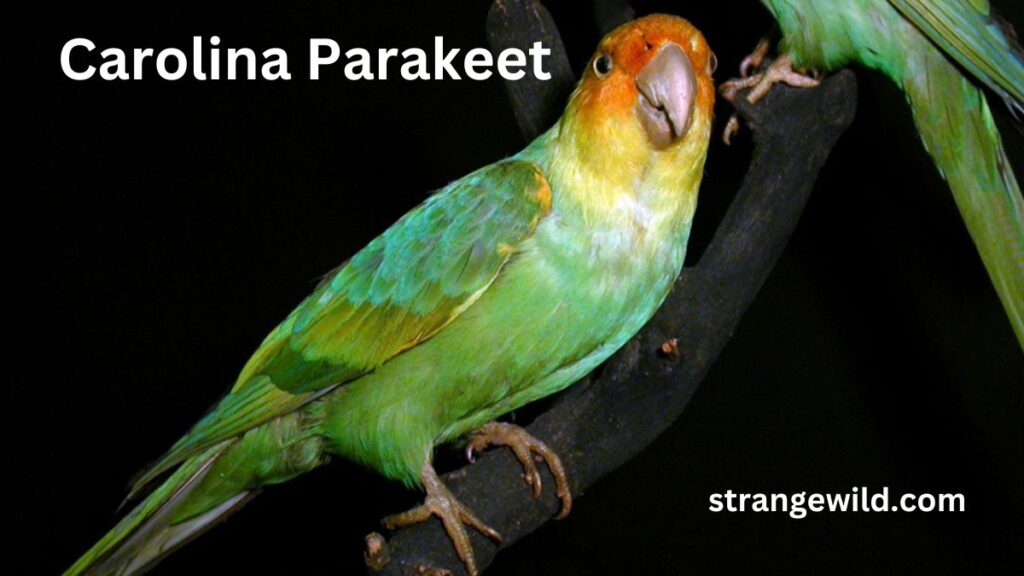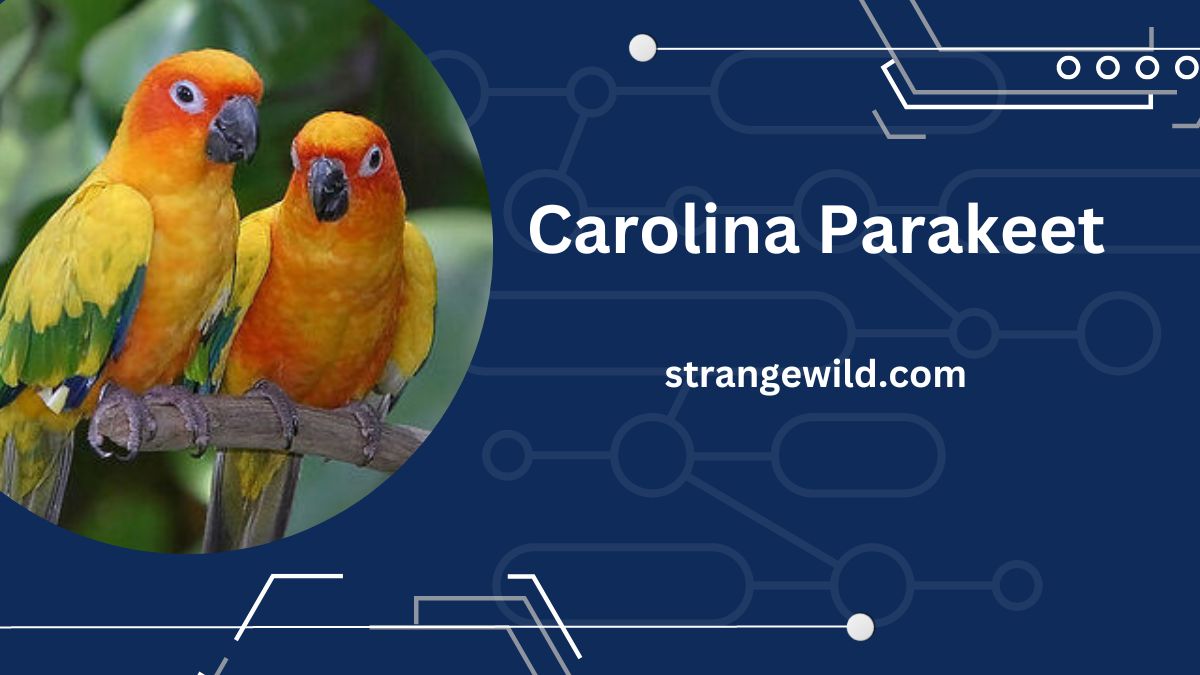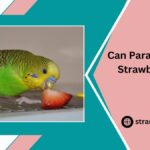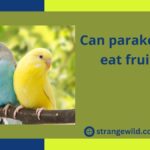Carolina Parakeet – You Need To Know
One of the rare parrot species that lived as far north as the United States is the Carolina parakeet.
Keep reading for more details…
Pictures of Carolina Parakeets
The Carolina parakeet, one of the few parrot species unique to the United States, was stunning in its vibrantly colored plumage. Sightings were formerly fairly common in the east, but population numbers drastically decreased throughout the ages due to a variety of circumstances, many of which were caused by humans but others of which were natural. Before it was officially declared extinct in 1939, the final known specimen perished in the Cincinnati Zoo in 1918. The study of captive or deceased individuals as well as anecdotes form the bulk of our knowledge of this species. Birds of Hawaii

Scientific Classification of the Carolina Parakeet
- Carolina Parakeet Locations: North-America
- Carolina Parakeet Scientific Classification
- Kingdom: Animalia
- Phylum: Chordata
- Class: Aves
- Order: Psittaciformes
- Family: Psittacidae
- Genus: †Conuropsis
- Scientific Name: †Conuropsis carolinensis
- Conservation Status of the Carolina Parakeet: Extinct
Physical Features of the Carolina Parakeet
- Color: Yellow, Blue, Green, Orange
- Skin Type: Feathers
- Lifespan: Up to 30 years
- Weight: 280g
- Length: 12-13 inches
Five Incredible Carolina Parakeet Facts
- The Carolina parakeet was divided into two distinct subspecies. The native distribution of each subspecies is still up for debate, however, there was reportedly very little overlap.
- The Carolina parakeet had a strong climbing ability. The fact that its beak is used as a sort of third limb to maneuver among the branches and trunks of trees is one of the more astonishing facts.
- Carolina parakeets have the potential to be very raucous. Sometimes, entire flocks might be heard from kilometers away.
- It’s been hypothesized that the Carolina parakeet may have been venomous because it consumed the dangerous cocklebur seeds. John J. Even Audubon noticed that some cats appeared to have perished after consuming this parakeet.
- It is thought that the Carolina parakeet could be saved from extinction. This is the procedure for using bits of DNA to restore an extinct species. In 2019, the genome of the bird was sequenced.
The Carolina Parakeet’s Location
A time ago, the eastern United States’ whole east coast was home to the Carolina parakeet. Its preferred habitat was woodlands close to rivers or wetlands. However, there is still some disagreement regarding its precise range. The edges of its native habitat were originally thought to reach as far west as Colorado and as far north or east as New York. But just a small number of confirmed historical sightings in a few states were used to create this map. Do Parakeets Mate for Life
An updated map from 2017 indicates a more limited range. While the other subspecies were relocated toward the interior of the United States, from Kansas to Ohio, the first subspecies most likely lived in Florida and the nearby coasts.
Nests of Carolina Parakeets
This species used common plant materials to build its nest in small tree hollows.
Scientific Name of the Carolina Parakeet
Conuropsis carolinensis is the official scientific name for the Carolina parakeet. Obviously, the Latin name for Carolina is Carolinensis. The term “conure,” which refers to various kinds of tiny to medium-sized parrots, is thought to have inspired the name of the genus Conuropsis, of which this species was the last living member. Conure is more of a bird-keeping phrase than a truly scientific one, though some people use the terms conure and parakeet interchangeably to describe the same species. This species belonged to the Psittacidae family of real parrots, which is also home to the well-known Scarlet macaw.
The size, appearance, and behavior of the Carolina parakeet
One of the most vibrant native birds in the entire United States when it was still living was the Carolina parakeet. They were brightly colored, with yellow around the neck, bright green or blue on the body, and red or orange on the face. Males were slightly larger than females, possibly measuring about 14 inches from head to tail, but otherwise had the same plumage. This species also possessed a big, pointed beak that was perfect for cracking open nuts and seeds.
At a time, flocks of 100 to 1,000 Carolina parakeets would fly together. Since they typically stayed within 30 miles of their home range, they were not known to migrate great distances. However, some groups might have relocated a little to survive the hard winter. A key component of their behavior was social cohesion. To strengthen their relationships with one another and maintain cleanliness, they were known to indulge in mutual preening and scratching.
Near the beginning of sunrise and sunset, foraging for food took place, but most of the day was spent sleeping, roosting, and bathing. When predators were around, the Carolina parakeet was known to shriek as a warning call. While roosting, it was mainly silent, but when flying, it made a very loud cacophony of noises.
Diet for Carolina Parakeets
The species of Carolina parakeet was omnivorous. It used its claws to secure food and its beak to tear it apart.
What food is consumed by Carolina parakeets?
The fruits and seeds of numerous different plants and trees, including the beech, elm, sycamore, maple, oak, and pine, were devoured by the Carolina parakeet. Insects were then added as a protein supplement, however, the cocklebur seemed to be their preferred food. Additionally, it appears that Carolina parakeets ingested salt licks and potentially salty water to supplement their diet with a little salt.
Predators, Threats, and Conservation Status of Carolina Parakeets
The wild population of this parakeet is entirely extinct. The main causes are attributed to deforestation and hunting; for them, the entrance of European settlers signaled the beginning of the end. However, as populations shrank and the species became more vulnerable to adverse shocks, the spread of illnesses and other ecological issues might have played a supporting role.
The Carolina parakeet is fed by what?
Hawks, eagles, and other raptors all preyed on this parakeet. Snakes, skunks, squirrels, and raccoons frequently preyed on eggs and chicks.
Reproduction, young, and molting in Carolina parakeets
At the time, a lot of information regarding the bird’s reproductive habits was not well documented. Although some modern sources asserted that this species was monogamous, there were also accounts of numerous birds sharing a nest. What is known is that the Carolina parakeet produced two to five eggs at a time and mated in the spring. The newborn chicks had all green feathers and whitish underparts.
The juvenile parakeets would develop their full-flight feathers and be prepared to fly after around 20 days. It was thought that raising and feeding the children was a responsibility shared by both parents. The juvenile parakeet would mature sexually and acquire adult plumage after a year. The species had a fairly long lifespan. It might live in captivity for up to 30 years.
The population of Carolina Parakeets
There are no living members of this species right now. It experienced a rapid phase of decline in the 18th and 19th centuries as a result of deforestation, hunting, and other reasons from which it never recovered. Populations seemed to be in complete decline towards the end of the 19th century. 1918 saw the passing of the species’ last known individual.
FAQs on Carolina Parakeets (Frequently Asked Questions)
Carolina parakeet migrates, nevertheless?
The species may have made a small amount of seasonal movement in the spring and fall, but it never ventured very far from its habitat.
How many eggs are laid by a Carolina parakeet?
Per clutch, this species produced two to five eggs.
The Carolina parakeet can fly how quickly?
Unknown is the flight speed. The bird was never captured on film while it was alive.
What is the wingspan of the Carolina parakeet?
This species’ wingspan measured between 21 and 23 inches.
When do the nests of Carolina parakeets disappear?
Less than three weeks after hatching, chicks started to fledge. They learned to fly and were essentially self-sufficient.
Why was the Carolina parakeet killed?
Undoubtedly, deforestation and some natural forces had a role in its decrease, but hunting was likely the single most significant influence. This was done as a form of intentional extinction, as well as for entertainment and business (their feathers were used to decorate clothing). Carolina parakeets were drawn to farmers’ domesticated fruit crops, which they occasionally destroyed while robbing. Farmers would shoot the parakeets while they fed in order to safeguard their crops.
Because of this species’ terrible propensity to visit a downed flock member, farmers frequently had to put out multiple birds at once. However, it was also agreed that the parakeet did have advantages because it prevented the invasive cocklebur from spreading. It is debatable how much of a role deforestation played in population disruption and fragmentation because nest sites were still widely distributed.
Is it true that the Carolina parakeet is extinct?
Yes, 1910 was the year that a wild Carolina parakeet was last sighted.
Can we bring the Carolina parakeet back?
Technically speaking, de-extinction is possible. From the remains of a long-dead Carolina parakeet, usable DNA was recovered and sequenced. One idea is to alter the genome of a few members of the closely related sun parakeet to resemble the Carolina parakeet. However, even if science advances and it becomes possible to recreate exact species from DNA snippets, people will invariably question the wisdom of de-extinction.
I appreciate your reading. Do you have any comments for us?





